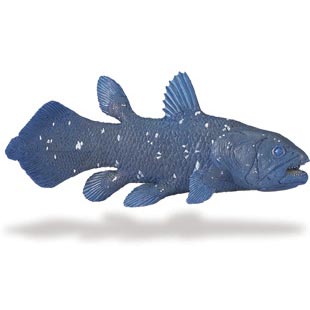What are Coelacanths? That is a Great Question
Fishy poser sent to Everything Dinosaur
At Everything Dinosaur we get sent lots of pictures and drawings from young dinosaur fans. In addition, we get emails asking us various questions about dinosaurs and other prehistoric animals. We do our best to try to answer each one that we receive.
The other day we got a question about Coelacanths, the emailer wanted to know when these strange fish first evolved and what the word “Coelacanth” means.
What are Coelacanths?
Coelacanths are members of an ancient class of fish called the Sarcopterygians (lobe-finned fishes). These fish have muscles and large bones at the base of their fins and it was once thought that Coelacanths used their fleshy fins to “walk” on the seabed, providing scientists with a link to those vertebrates that were the first back-boned animals to walk on land. This theory, once very popular amongst palaeontologists has now been largely disregarded and Coelacanths are not thought to be closely related to the terrestrial vertebrates. The first fossils of Coelacanths can be found in Mid-Devonian aged rocks, indicating that this particular type of fish evolved around 380 million years ago.
A Model of a Coelacanth (Safari Ltd)
Picture credit: Everything Dinosaur/Safari Ltd
Coelacanths were thought to have become extinct approximately 66 million years ago, however, in 1938, a trawler fishing off the Chalumna river estuary (South Africa) caught a strange looking fish and once this fish had been returned to port, Marjorie Coutney-Latimer, the curator of the nearby East London museum was notified and it was from her sketches and information that led to this specimen being identified as a Coelacanth. It was not until 1952 that a second Coelacanth specimen was caught. In 1997, a second species of Coelacanth was identified. This Pacific species was discovered living in deep water off the islands of Indonesia.
The word Coelacanth means “hollow spines” a reference to the spines that support this primitive bony fish’s fleshy fins. Extant specimens closely resemble a genus of prehistoric Coelacanth called Macropoma which became extinct at the end of the Cretaceous period, at around the same time the dinosaurs died out. This extinction took place approximately sixty-six million years ago.
The largest specimens of Coelacanths living today can reach lengths in excess of five feet and these deep bodied fish with their large scales can weigh more than eighty kilogrammes, about as much as a man. It is thought that these sluggish creatures feed mostly at night, sucking into their large mouths crabs, lobsters, shrimps, jellyfish and small fish.
To view a model of a Coelacanth and other amazing prehistoric creatures: Wild Safari Dinos – Prehistoric Animal Models.


